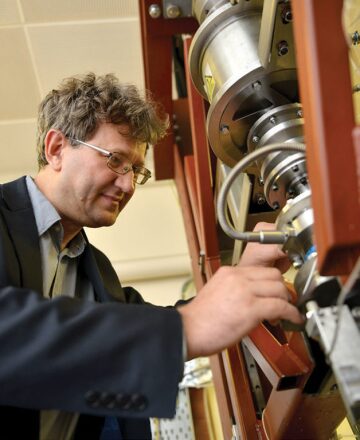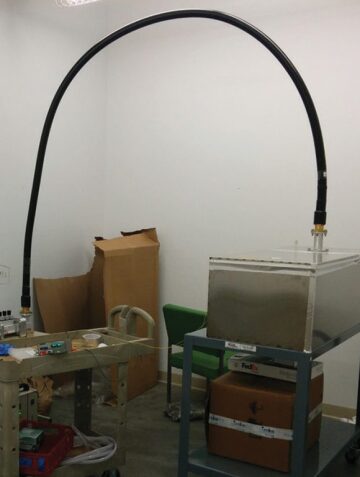University research and development is continuing at a steady rate, despite sustained low oil prices. For now, money allocated by the oil and gas industry in previous years is still available for many academic institutions. However, oil prices may eventually take a toll on funding if they remain low when it is time for companies to renew their existing commitments. “Next year is when we will look and see if we have our sponsors, or (determine if) some of them cannot continue,” said Manika Prasad, associate petroleum engineering professor at Colorado School of Mines. Other universities around the world are facing the same pressures and uncertainties.
University of Aberdeen
Located near the North Sea in one of the world’s major oil and gas capitals, the University of Aberdeen employs more than 150 professors working on energy-related research.
“We are not just an oil and gas school at Aberdeen, we have a very broad range of sciences being taught and worked on. So, sometimes the interaction between them produces something unusual,” said John Scrimgeour, executive director of the university’s Aberdeen Institute of Energy.
One idea that originated outside of the university’s traditional petroleum research themes is resonance enhanced drilling (RED), which was first conceptualized by the applied mathematics faculty.
Traditional rotary drill bits spin at the bottom of the hole and use cutters to crush rock. RED, however, includes an agitator device above the drill bit that increases the rate of penetration by producing targeted vibrations. The system measures a rock type’s resonant frequency and adjusts the vibrations accordingly.
Besides an improved rate of penetration, the use of resonance techniques creates much less wear on the bit and finer cuttings that are more easily transported, said Scrimgeour. Researchers have already tested RED on granite in the laboratory.

The project has so far been funded by the United Kingdom government, but now the university is looking for help from the oil and gas industry. “Now, we need to get someone to build a prototype and prove it in a well, which is always a difficult part of developing new technologies,” said Scrimgeour.
The university is also active in enhanced oil recovery (EOR) research, something that many North Sea producers thought would not work in the region when development began on a large scale in the early 1980s.
“The conventional wisdom back then was that in order to have EOR, you needed close well spacing, high residual oil saturation, and cheap operation conditions—everything that the North Sea wasn’t,” he said. Today, companies operating in the region, such as BP, are revisiting older fields looking to increase recovery factors.
Currently, faculty members are working on polymer flooding and studying how wettability and its heterogeneity affect recovery for the North Sea and other fields around the world.
Subsea engineering is another oil and gas-related discipline in which the university offers degrees and conducts research.
In May, the university signed an agreement with the Pusan National University’s Korea Shipbuilding and Offshore Research Institute to form a campus that will be centered on the study of and research on subsea, topsides, and petroleum engineering. The campus is expected to open in fall of next year.
University of Alberta
For decades, operators have attempted to use buried electromagnetic coils as an alternative to steamflooding in heavy oil reservoirs, but they consume a great deal of energy and take a long time to work.
Tayfun Babadagli, who heads the University of Alberta’s Enhanced Oil and Gas Recovery and Reservoir Characterization group, is leading research to make electromagnetic heating a practical process with the use of nanotechnology.
When a solution of metallic nanoparticles is injected into a formation, the particles can trap heat being emitted by the coils, which increases heating efficiency and reduces oil viscosity at the same time. Nickel was found by the group to be the best metal for the job.
If the process can be made economical, it could be used as an alternative recovery method in places where steam injection may not be possible, such as deep reservoirs or oil shale.
In past years, the team has researched hybrid enhanced recovery methods, such as steam over solvent recovery in fractured reservoirs (SOS-FR), which received Canadian patent protection this year.
Producers heat up the rock matrix around the reservoir by injecting steam, then they inject a solvent, which starts crude production. After the initial production phase, more steam is injected to vaporize and recover the solvent. The second steam phase also produces additional oil.

There are multiple advantages to using this method beyond its increased recovery factor, according to Babadagli. “We can minimize the amount of solvent used, which is expensive. We can also minimize the amount of CO2 emitted,” he said. Instead of leaving it in the ground, recovering the solvent can make its use economical in situations that might not otherwise be.
As an added benefit, the process will sometimes result in an upgrading of heavy oil and bitumen downhole, saving producers energy they would use in upgrading later on the surface.
In order to improve the execution of chemical-based recovery methods, Babadagli’s students use laser imaging to watch the behavior of solvents downhole. Laser emitters are deployed at the heel or toe of injection wells to create 3D pictures of where solvents travel when introduced.
Additional themes that the group has worked on this year include wettability alteration using nanoparticles, bitumen recovery from carbonates, and solvent-based recovery after cold production of heavy oil.
Research this year has been largely unharmed by the drop in oil prices, because partner companies signed 5-year agreements. The consortium is in its fourth year. “Now, when I approach new companies about contributing, they say they are worried about budgets, but so far there has not been a direct effect on our research,” he said.
The group has received funding from a variety of partners, including Suncor, Touchstone Exploration, Pemex, Husky Energy, Sherritt International, Apex Engineering, Saudi Aramco, and the Natural Sciences and Engineering Research Council of Canada, where Babadagli serves as its industrial research chair in unconventional oil recovery. The program has involved six graduate students and six doctoral students in the past year.
Colorado School of Mines
As the industry’s ability to create numerical models of the subsurface continues to improve, one fact remains unchanged: Models are only as accurate as the data used to create them.
Manika Prasad, associate professor of petroleum engineering at the Colorado School of Mines, started the Rock Physics and Petrophysics of Organics, Clay, Shale, and Sand initiative in 2011 to improve the accuracy of subsurface models by creating standards for rock physics and geomechanical data collection.
Students and researchers investigate the properties of source rock to learn more about its in-situ behavior and how measurements of the rock might be affected by environmental conditions.
“We take very careful measurements that can be used as benchmarks for modeling and for simulation,” said Prasad. “We measure the constants, so that people can use those numbers when they are making Earth models.”
By relying on Prasad’s benchmarks, companies can fill certain gaps in their models without manually taking measurements themselves, thereby decreasing the risk of error.
The consortium and its collaborators have applied for patents relating to the measurement of surface relaxivity and ways of identifying and quantifying emulsion properties in producing oil and gas wells. Both processes use nuclear magnetic resonance (NMR).
The group also collaborates with other disciplines, such as geophysics, physics, materials science, and chemical engineering, for experiments that investigate mechanical, elastic, and electrical response of reservoir rocks at various scales, nanometer (pore scale), millimeter (core scale), centimeter to meter (log scale), and tens of meters (seismic scale).
“Right now, people are using our work for identification and estimation of pore-size distribution and velocity evolution, for example, to put into reverse calculations,” said Prasad. “They are also using it in reservoir simulation to see what changes during production and how much you can really produce.”
The group is in the process of building a pressure vessel from scratch for use in NMR and hydrate research. “We could have gone the easier way and bought something, but there would be no learning experience for the students,” said Prasad.
Work is funded by a consortium that meets once a year to give suggestions on new research themes and to listen to student presentations.
Corporate partners provide Prasad’s students with field data that can be difficult for a university-based consortium to obtain from an industry wary of sharing proprietary information. “We’ve been very lucky in that sense. We’ve had samples, preserved cores, and log data donated to us, because the work we are doing is so unique,” she said.
Prasad said that the economy has caused some sponsors to stop their participation because they are withdrawing from unconventional operations altogether. However, the university group still has the funding to continue its research.
Texas A&M University
This year, Texas A&M University’s Crisman Institute for Petroleum Research has been shifting its research focus toward projects that will improve recovery in shale reservoirs.
The institute was founded in 1982 with the broad directive of producing advances in upstream technology. However, the industry demand for goal-based research that offers a higher return on investment has led the faculty to narrow its mission.
A major goal is to develop comprehensive models that will allow operators to enter new shale plays with a more accurate understanding of what will happen in the future. “Industry can take production data and geology, then model it to determine what has happened, but then they have trouble using those models to predict what’s going to happen in the next play or even the next well,” said petroleum engineering professor Stephen Holditch, former head of the Petroleum Engineering Department.

Next year, the institute will begin the process of integrating disparate disciplines to further this research.
“We plan to bring together geology, geophysics, nanotechnology, molecular studies, reservoir modeling, and hydraulic fracturing to take complete data sets from shale reservoirs and analyze them from geology to production, to come up with the fundamentals for building predictive models,” said Holditch.
Another important theme in the institute’s pivot toward shale is nanotechnology, a group that is led by researcher Jenn-Tai Liang.
Hydraulic fracturing requires the use of many chemicals working together under extreme conditions. Nanoparticles can be used downhole to ensure that chemicals behave properly.
The technology allows oilfield chemicals to survive the harsh downhole environment long enough to be delivered to the desired part of a formation without being diluted or rendered ineffective in the process. Nanomaterials shield the active chemicals from heat, pressure, and other deleterious conditions, allowing them to be released at a predetermined time and rate.
To examine how the chemicals will react downhole, the institute’s equipment allows researchers to simulate the behavior of compounds in oxygen-free conditions at what would be ambient temperatures inside a well.
One project investigates the uses of nanoparticles to encapsulate and delay the release of enzymes that break down gels so they can be cleaned out of the hole. If gels break down too quickly, they will be unable to effectively carry proppant deep into the formation.
By keeping the fracturing fluid viscous for a longer period of time, it can better carry proppant particles to the right places in the formation to prop fractures and increase oil and gas production.

